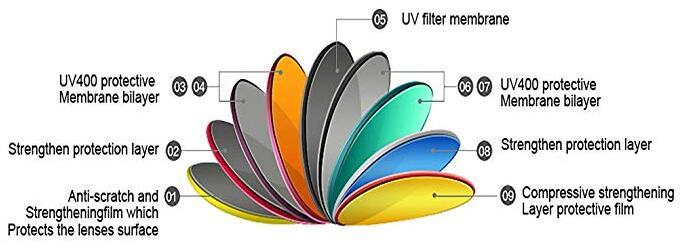
The eye is a very important visual organ of human beings, and its structure is very precise and complicated. There are a variety of "membranes" in the human eye, each of which has its own unique role, and the importance of the "membrane" to the eye is evident. But not only the eyes, but also the layer on the glasses, and the variety of glasses, the layer is not so much a film, in essence, is a special microstructure, just because the structure is continuous and the thickness is very thin (molecular level), so It is called "layer". Different glasses layers have different microscopic molecular structures, which bring different protective effects.

Anti-fog layer
The anti-fog film is also called a hydrophilic nano-film layer, which can overcome the surface tension of water droplets and greatly reduce the chance of fog formation. When the lens of this film layer is used together with a special mirror cloth, a rubbing can provide a good and lasting anti-fog effect. Simply put, the anti-fog film does not repel the water droplets, but arranges the water mist molecules on the surface of the lens to be more tight and smooth, forming a "water film" with good light transmission.
Waterproof layer
The waterproof membrane is a very thin film that makes the surface of the lens hydrophobic. Oil and water droplets are difficult to stay on the surface of the lens and fall off automatically. Therefore, the waterproof and antifouling effect is the same as the rolling of the water droplets on the lotus leaf. . The surface of the waterproof membrane is actually a small bump. The gap between the bumps is too small and smaller than the water molecules, so that when the water molecules fall on it, they cannot be "embedded" between the gaps. Rolled down under the force of gravity. The essence of the waterproof membrane is to reduce the contact area between water and oil and the lens, so that the oil and water droplets are not easily adhered to the surface of the lens.
Dustproof layer
The dust-proof function of the lens, due to the use of i-technology technology, makes the molecular structure of the lens surface more dense, and the dust cannot be “inserted”. The principle is actually similar to the waterproof membrane.
Anti-reflective layer
The anti-reflective film is also called anti-reflective film, that is, by coating a plurality of transparent materials with different refractive indexes and different thicknesses on the front surface of the lens, the principle of optical interference is used to reduce the excess reflected light on the surface of the lens. When the lens is coated with an anti-reflection film, the transparency of the light increases, and the wearer feels that the glare is reduced and the object is more realistic and bright.
Anti-scratch layer
In order to improve the anti-wear ability of the lens, it is necessary to use a hardening liquid containing an organic matrix and inorganic ultrafine particles, and a hard film is coated on the surface of the lens to make the surface of the lens have both toughness and hardness. This film is a wear-resistant film that reduces scratch damage.
UV protection & anti-blue layer
The medium-long-wave ultraviolet rays in the sun are very harmful to the human eye and the skin. And independent research has shown that 50% of the ultraviolet rays injected into the human eye come from the reflection of the back surface of the lens. Similarly, studies have found that blue-violet light in the wavelength range of 415-455 nm is the most harmful to retinal cells.
In order to deal with the damage of ultraviolet and blue-violet light to the human eye, a technique called "broad spectrum coating" came into being. The biggest advantage of this "membrane" structure is the ability to intelligently filter harmful light through normal light.
It is precisely because of these different lens layers that our eyes are protected. When choosing glasses, we must pay more attention to the layers on each eye and choose the film we need for our eyes. Better protection.